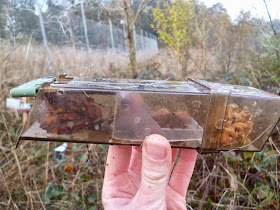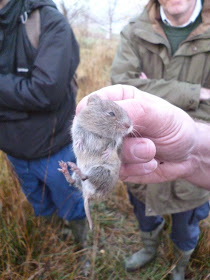I have been fortunate enough to meet some really passionate conservationists through the Wildlife Trusts, who remind me the most essential part of any scientific study is to define the question which needs answering.
North West Zone at Gatwick, adjacent to the River Mole grasslands
Subject mammal: orangey fur, big ol' eyes, small ears and a prehensile tail
The Harvest Mouse (Micromys minutus) is a rather iconic, yet understudied mammal in our fair isles, so folk like Jim Jones and Laurie Jackson are working to fill the gaps in our knowledge. We know that Harvest Mice are present at the airport, but how well are they doing and what are their habits once autumn rolls in and the wetland water levels rise? Earlier this month, Jim and myself oversaw a survey in the North West Zone, tying into a larger population study by the Surrey Mammal Group.
Monday Evening: Setting up on site
Jim mixes up a tasty snack for our small mammal traps
(peanut butter, apple, oats and mealworms)
The aim is to compare the effectiveness of 3 types of humane mammal traps at different heights in the vegetation. This could help inform conservationists of the best way to target sample Harvest Mouse populations.
Longworth Trap on a stand
Sherman Trap on a stand
Trip Trap (which doesn't always trigger, meaning free food and accommodation for luckier beasties)
And did we find what we were looking for? Here is a photo diary of our results...
Day 1:
6.30am. Cool and misty morning along the River Mole, north-west of the airfield
Trainees arrive on site and Jim gives us a brief on the methodology
Our first capture is a young Field Vole (Microtus agrestis), gently scruffed to determine the gender
Noon session: a less-than-amused Wren (Troglodytes troglodytes) popped out of a longworth trap, none the worse for wear!
Evening session: 6.30pm
Persistently cute; same Field Vole (Microtus agrestis) gets emptied out for the 3rd time today
Peak Counts:
Field Vole (Microtus agrestis) x 2
Wood Mouse (Apodemus sylvaticus) x 3
Wren (Troglodytes troglodytes) x 1
Day 2:
Wood Mouse (Apodemus sylvaticus)
Yellow-necked Mouse (Apodemus falvicollis), a larger, longer-toothed cousin of the Wood Mouse
Peter bravely demonstrates how to scruff a Yellow-necked Mouse
Peak counts:
Bank Vole (Myodes glareolus) x 2
Wood Mouse (Apodemus sylvaticus) x 8
Yellow-necked Mouse (Apodemus flavicollis) x 1
Day 3:
We don't normally trap in persistently cold conditions due to welfare issues, but last night's temperature dropped to a frostier level than expected. Luckily no casualties, plus many of the traps were frozen open with all the bait snaffled (but plenty of rodent poop left in return).
Survey form
Noon session: Joe and Megan photograph the contents of a trap...
Which turns out to be our first Common Shrew (Sorex araneus)
...Still no sign of that evasive Micro-mouse!
Peak Counts:
Bank Vole (Myodes glareolus) x 2
Field Vole (Microtus agrestis) x 1
Wood Mouse (Apodemus sylvaticus) x 3
Yellow-necked Mouse (Apodemus flavicollis) x 1
Common Shrew (Sorex araneus) x 1
Day 4:
Kathryn and Sue helping to replenish bait in the traps
Evening session: Trip-trap; resolutely empty
Bank Vole (Myodes glareolus)
Peak Counts:
Bank Vole (Myodes glareolus) x 2
Field Vole (Microtus agrestis) x 2
Wood Mouse (Apodemus sylvaticus) x 6
Yellow-necked Mouse (Apodemus flavicollis) x 2
Day 5: Final morning
A relatively peaceful moment at the airport, reminds me of the film 'Warm Bodies'!
Jim holds the final Field Vole
Final Field Vole is having trouble letting go...
(perhaps after being spoiled by days of free full-board accommodation)
Peak Counts:
Bank Vole (Myodes glareolus) x 1
Field Vole (Microtus agrestis) x 2
Wood Mouse (Apodemus sylvaticus) x 1
Yellow-necked Mouse (Apodemus flavicollis) x 3
Apparently, Harvest Mice will take their holidays around this time of year while the rest of us are still working hard. Who knows why we didn't find any, but judging from the number of nests we have seen on this site, 2015 will be be the year!














































